Comparison of Primary Healthcare Services in India and Australia
VerifiedAdded on 2023/05/29
|13
|3893
|472
AI Summary
This article compares the primary healthcare initiatives in India and Australia, shedding light on the social determinants of health in both nations. It also explains the role of nurses in ensuring better primary healthcare services globally.
Contribute Materials
Your contribution can guide someone’s learning journey. Share your
documents today.
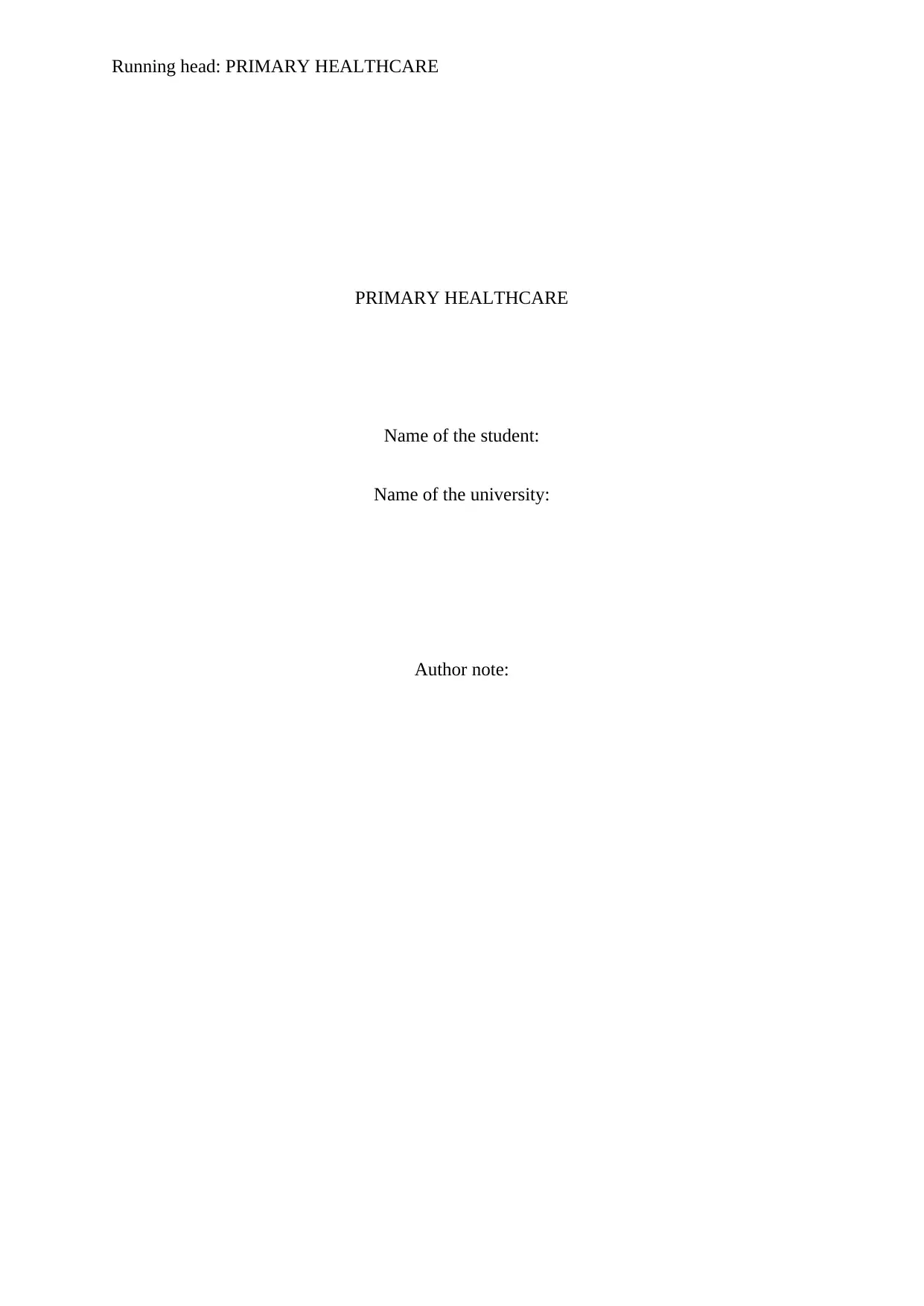
Running head: PRIMARY HEALTHCARE
PRIMARY HEALTHCARE
Name of the student:
Name of the university:
Author note:
PRIMARY HEALTHCARE
Name of the student:
Name of the university:
Author note:
Secure Best Marks with AI Grader
Need help grading? Try our AI Grader for instant feedback on your assignments.
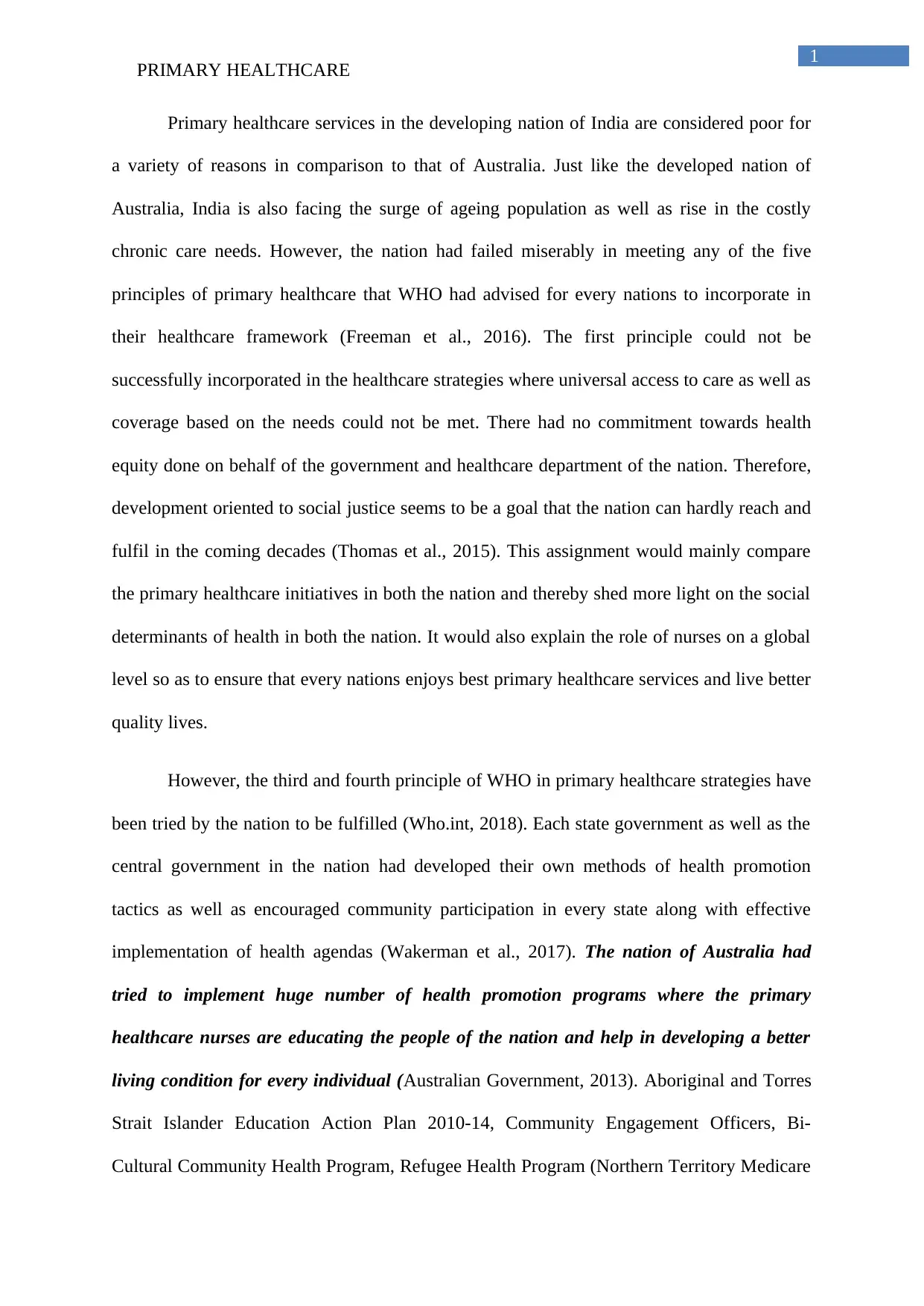
1
PRIMARY HEALTHCARE
Primary healthcare services in the developing nation of India are considered poor for
a variety of reasons in comparison to that of Australia. Just like the developed nation of
Australia, India is also facing the surge of ageing population as well as rise in the costly
chronic care needs. However, the nation had failed miserably in meeting any of the five
principles of primary healthcare that WHO had advised for every nations to incorporate in
their healthcare framework (Freeman et al., 2016). The first principle could not be
successfully incorporated in the healthcare strategies where universal access to care as well as
coverage based on the needs could not be met. There had no commitment towards health
equity done on behalf of the government and healthcare department of the nation. Therefore,
development oriented to social justice seems to be a goal that the nation can hardly reach and
fulfil in the coming decades (Thomas et al., 2015). This assignment would mainly compare
the primary healthcare initiatives in both the nation and thereby shed more light on the social
determinants of health in both the nation. It would also explain the role of nurses on a global
level so as to ensure that every nations enjoys best primary healthcare services and live better
quality lives.
However, the third and fourth principle of WHO in primary healthcare strategies have
been tried by the nation to be fulfilled (Who.int, 2018). Each state government as well as the
central government in the nation had developed their own methods of health promotion
tactics as well as encouraged community participation in every state along with effective
implementation of health agendas (Wakerman et al., 2017). The nation of Australia had
tried to implement huge number of health promotion programs where the primary
healthcare nurses are educating the people of the nation and help in developing a better
living condition for every individual (Australian Government, 2013). Aboriginal and Torres
Strait Islander Education Action Plan 2010-14, Community Engagement Officers, Bi-
Cultural Community Health Program, Refugee Health Program (Northern Territory Medicare
PRIMARY HEALTHCARE
Primary healthcare services in the developing nation of India are considered poor for
a variety of reasons in comparison to that of Australia. Just like the developed nation of
Australia, India is also facing the surge of ageing population as well as rise in the costly
chronic care needs. However, the nation had failed miserably in meeting any of the five
principles of primary healthcare that WHO had advised for every nations to incorporate in
their healthcare framework (Freeman et al., 2016). The first principle could not be
successfully incorporated in the healthcare strategies where universal access to care as well as
coverage based on the needs could not be met. There had no commitment towards health
equity done on behalf of the government and healthcare department of the nation. Therefore,
development oriented to social justice seems to be a goal that the nation can hardly reach and
fulfil in the coming decades (Thomas et al., 2015). This assignment would mainly compare
the primary healthcare initiatives in both the nation and thereby shed more light on the social
determinants of health in both the nation. It would also explain the role of nurses on a global
level so as to ensure that every nations enjoys best primary healthcare services and live better
quality lives.
However, the third and fourth principle of WHO in primary healthcare strategies have
been tried by the nation to be fulfilled (Who.int, 2018). Each state government as well as the
central government in the nation had developed their own methods of health promotion
tactics as well as encouraged community participation in every state along with effective
implementation of health agendas (Wakerman et al., 2017). The nation of Australia had
tried to implement huge number of health promotion programs where the primary
healthcare nurses are educating the people of the nation and help in developing a better
living condition for every individual (Australian Government, 2013). Aboriginal and Torres
Strait Islander Education Action Plan 2010-14, Community Engagement Officers, Bi-
Cultural Community Health Program, Refugee Health Program (Northern Territory Medicare
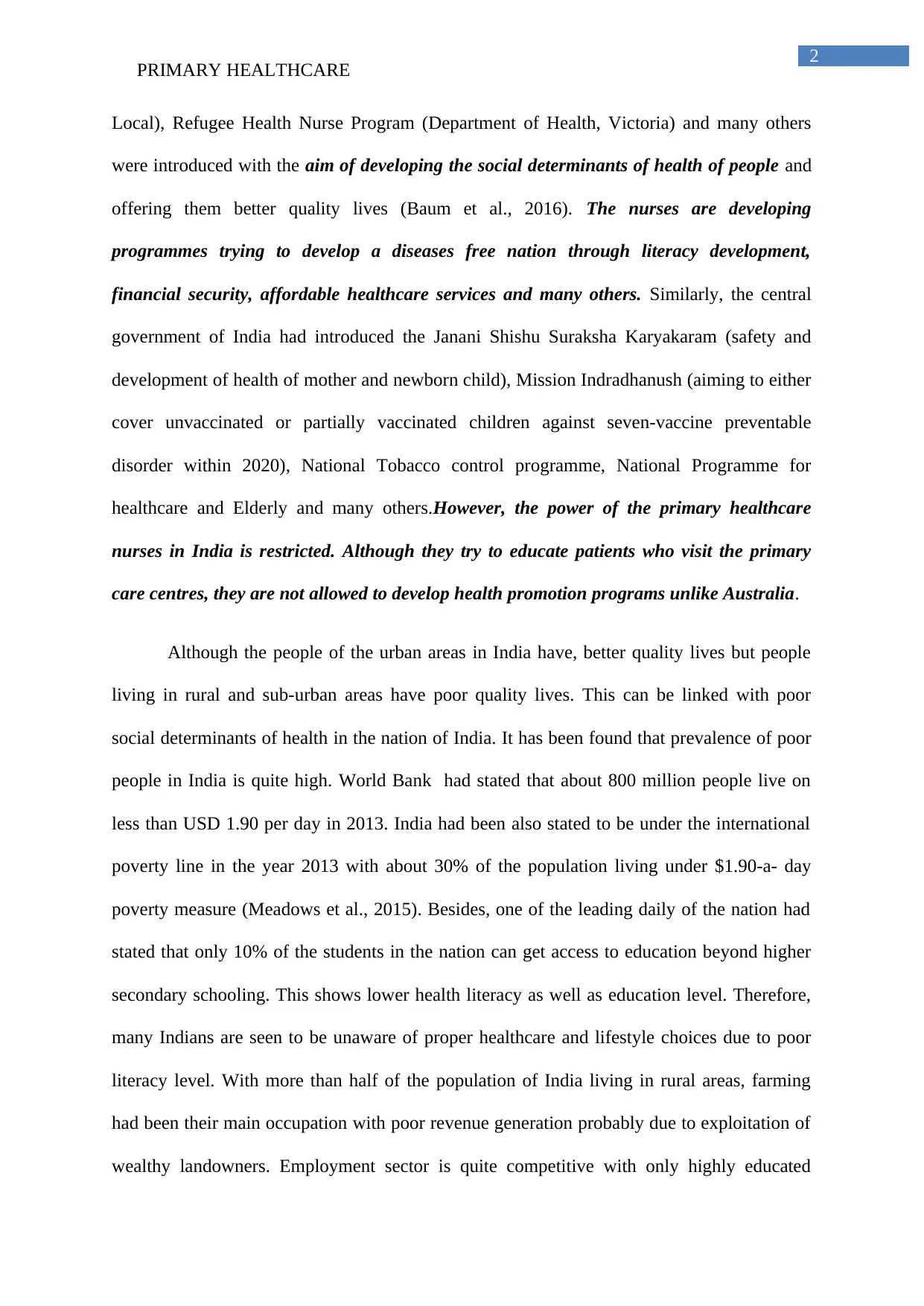
2
PRIMARY HEALTHCARE
Local), Refugee Health Nurse Program (Department of Health, Victoria) and many others
were introduced with the aim of developing the social determinants of health of people and
offering them better quality lives (Baum et al., 2016). The nurses are developing
programmes trying to develop a diseases free nation through literacy development,
financial security, affordable healthcare services and many others. Similarly, the central
government of India had introduced the Janani Shishu Suraksha Karyakaram (safety and
development of health of mother and newborn child), Mission Indradhanush (aiming to either
cover unvaccinated or partially vaccinated children against seven-vaccine preventable
disorder within 2020), National Tobacco control programme, National Programme for
healthcare and Elderly and many others.However, the power of the primary healthcare
nurses in India is restricted. Although they try to educate patients who visit the primary
care centres, they are not allowed to develop health promotion programs unlike Australia.
Although the people of the urban areas in India have, better quality lives but people
living in rural and sub-urban areas have poor quality lives. This can be linked with poor
social determinants of health in the nation of India. It has been found that prevalence of poor
people in India is quite high. World Bank had stated that about 800 million people live on
less than USD 1.90 per day in 2013. India had been also stated to be under the international
poverty line in the year 2013 with about 30% of the population living under $1.90-a- day
poverty measure (Meadows et al., 2015). Besides, one of the leading daily of the nation had
stated that only 10% of the students in the nation can get access to education beyond higher
secondary schooling. This shows lower health literacy as well as education level. Therefore,
many Indians are seen to be unaware of proper healthcare and lifestyle choices due to poor
literacy level. With more than half of the population of India living in rural areas, farming
had been their main occupation with poor revenue generation probably due to exploitation of
wealthy landowners. Employment sector is quite competitive with only highly educated
PRIMARY HEALTHCARE
Local), Refugee Health Nurse Program (Department of Health, Victoria) and many others
were introduced with the aim of developing the social determinants of health of people and
offering them better quality lives (Baum et al., 2016). The nurses are developing
programmes trying to develop a diseases free nation through literacy development,
financial security, affordable healthcare services and many others. Similarly, the central
government of India had introduced the Janani Shishu Suraksha Karyakaram (safety and
development of health of mother and newborn child), Mission Indradhanush (aiming to either
cover unvaccinated or partially vaccinated children against seven-vaccine preventable
disorder within 2020), National Tobacco control programme, National Programme for
healthcare and Elderly and many others.However, the power of the primary healthcare
nurses in India is restricted. Although they try to educate patients who visit the primary
care centres, they are not allowed to develop health promotion programs unlike Australia.
Although the people of the urban areas in India have, better quality lives but people
living in rural and sub-urban areas have poor quality lives. This can be linked with poor
social determinants of health in the nation of India. It has been found that prevalence of poor
people in India is quite high. World Bank had stated that about 800 million people live on
less than USD 1.90 per day in 2013. India had been also stated to be under the international
poverty line in the year 2013 with about 30% of the population living under $1.90-a- day
poverty measure (Meadows et al., 2015). Besides, one of the leading daily of the nation had
stated that only 10% of the students in the nation can get access to education beyond higher
secondary schooling. This shows lower health literacy as well as education level. Therefore,
many Indians are seen to be unaware of proper healthcare and lifestyle choices due to poor
literacy level. With more than half of the population of India living in rural areas, farming
had been their main occupation with poor revenue generation probably due to exploitation of
wealthy landowners. Employment sector is quite competitive with only highly educated
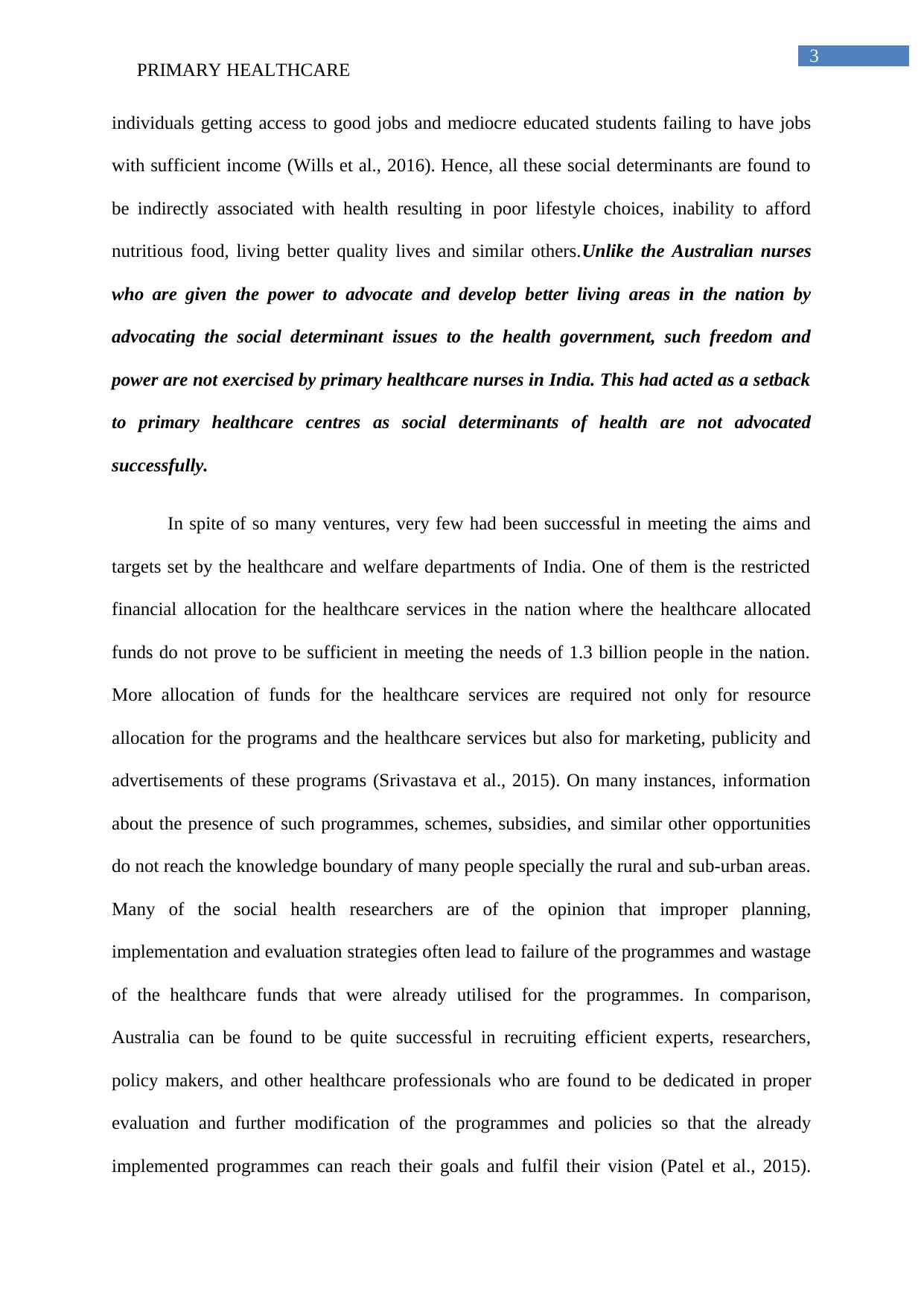
3
PRIMARY HEALTHCARE
individuals getting access to good jobs and mediocre educated students failing to have jobs
with sufficient income (Wills et al., 2016). Hence, all these social determinants are found to
be indirectly associated with health resulting in poor lifestyle choices, inability to afford
nutritious food, living better quality lives and similar others.Unlike the Australian nurses
who are given the power to advocate and develop better living areas in the nation by
advocating the social determinant issues to the health government, such freedom and
power are not exercised by primary healthcare nurses in India. This had acted as a setback
to primary healthcare centres as social determinants of health are not advocated
successfully.
In spite of so many ventures, very few had been successful in meeting the aims and
targets set by the healthcare and welfare departments of India. One of them is the restricted
financial allocation for the healthcare services in the nation where the healthcare allocated
funds do not prove to be sufficient in meeting the needs of 1.3 billion people in the nation.
More allocation of funds for the healthcare services are required not only for resource
allocation for the programs and the healthcare services but also for marketing, publicity and
advertisements of these programs (Srivastava et al., 2015). On many instances, information
about the presence of such programmes, schemes, subsidies, and similar other opportunities
do not reach the knowledge boundary of many people specially the rural and sub-urban areas.
Many of the social health researchers are of the opinion that improper planning,
implementation and evaluation strategies often lead to failure of the programmes and wastage
of the healthcare funds that were already utilised for the programmes. In comparison,
Australia can be found to be quite successful in recruiting efficient experts, researchers,
policy makers, and other healthcare professionals who are found to be dedicated in proper
evaluation and further modification of the programmes and policies so that the already
implemented programmes can reach their goals and fulfil their vision (Patel et al., 2015).
PRIMARY HEALTHCARE
individuals getting access to good jobs and mediocre educated students failing to have jobs
with sufficient income (Wills et al., 2016). Hence, all these social determinants are found to
be indirectly associated with health resulting in poor lifestyle choices, inability to afford
nutritious food, living better quality lives and similar others.Unlike the Australian nurses
who are given the power to advocate and develop better living areas in the nation by
advocating the social determinant issues to the health government, such freedom and
power are not exercised by primary healthcare nurses in India. This had acted as a setback
to primary healthcare centres as social determinants of health are not advocated
successfully.
In spite of so many ventures, very few had been successful in meeting the aims and
targets set by the healthcare and welfare departments of India. One of them is the restricted
financial allocation for the healthcare services in the nation where the healthcare allocated
funds do not prove to be sufficient in meeting the needs of 1.3 billion people in the nation.
More allocation of funds for the healthcare services are required not only for resource
allocation for the programs and the healthcare services but also for marketing, publicity and
advertisements of these programs (Srivastava et al., 2015). On many instances, information
about the presence of such programmes, schemes, subsidies, and similar other opportunities
do not reach the knowledge boundary of many people specially the rural and sub-urban areas.
Many of the social health researchers are of the opinion that improper planning,
implementation and evaluation strategies often lead to failure of the programmes and wastage
of the healthcare funds that were already utilised for the programmes. In comparison,
Australia can be found to be quite successful in recruiting efficient experts, researchers,
policy makers, and other healthcare professionals who are found to be dedicated in proper
evaluation and further modification of the programmes and policies so that the already
implemented programmes can reach their goals and fulfil their vision (Patel et al., 2015).
Secure Best Marks with AI Grader
Need help grading? Try our AI Grader for instant feedback on your assignments.
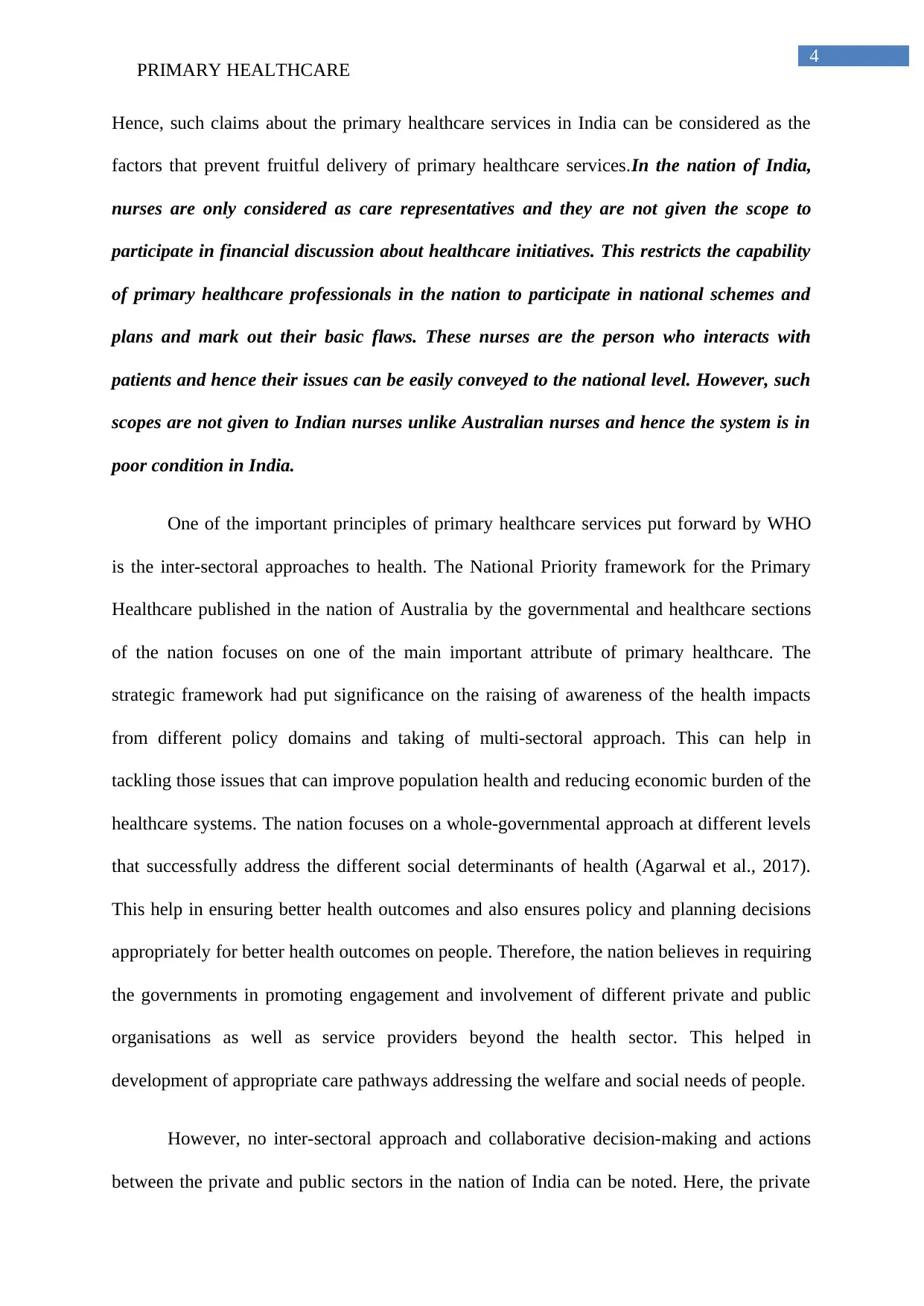
4
PRIMARY HEALTHCARE
Hence, such claims about the primary healthcare services in India can be considered as the
factors that prevent fruitful delivery of primary healthcare services.In the nation of India,
nurses are only considered as care representatives and they are not given the scope to
participate in financial discussion about healthcare initiatives. This restricts the capability
of primary healthcare professionals in the nation to participate in national schemes and
plans and mark out their basic flaws. These nurses are the person who interacts with
patients and hence their issues can be easily conveyed to the national level. However, such
scopes are not given to Indian nurses unlike Australian nurses and hence the system is in
poor condition in India.
One of the important principles of primary healthcare services put forward by WHO
is the inter-sectoral approaches to health. The National Priority framework for the Primary
Healthcare published in the nation of Australia by the governmental and healthcare sections
of the nation focuses on one of the main important attribute of primary healthcare. The
strategic framework had put significance on the raising of awareness of the health impacts
from different policy domains and taking of multi-sectoral approach. This can help in
tackling those issues that can improve population health and reducing economic burden of the
healthcare systems. The nation focuses on a whole-governmental approach at different levels
that successfully address the different social determinants of health (Agarwal et al., 2017).
This help in ensuring better health outcomes and also ensures policy and planning decisions
appropriately for better health outcomes on people. Therefore, the nation believes in requiring
the governments in promoting engagement and involvement of different private and public
organisations as well as service providers beyond the health sector. This helped in
development of appropriate care pathways addressing the welfare and social needs of people.
However, no inter-sectoral approach and collaborative decision-making and actions
between the private and public sectors in the nation of India can be noted. Here, the private
PRIMARY HEALTHCARE
Hence, such claims about the primary healthcare services in India can be considered as the
factors that prevent fruitful delivery of primary healthcare services.In the nation of India,
nurses are only considered as care representatives and they are not given the scope to
participate in financial discussion about healthcare initiatives. This restricts the capability
of primary healthcare professionals in the nation to participate in national schemes and
plans and mark out their basic flaws. These nurses are the person who interacts with
patients and hence their issues can be easily conveyed to the national level. However, such
scopes are not given to Indian nurses unlike Australian nurses and hence the system is in
poor condition in India.
One of the important principles of primary healthcare services put forward by WHO
is the inter-sectoral approaches to health. The National Priority framework for the Primary
Healthcare published in the nation of Australia by the governmental and healthcare sections
of the nation focuses on one of the main important attribute of primary healthcare. The
strategic framework had put significance on the raising of awareness of the health impacts
from different policy domains and taking of multi-sectoral approach. This can help in
tackling those issues that can improve population health and reducing economic burden of the
healthcare systems. The nation focuses on a whole-governmental approach at different levels
that successfully address the different social determinants of health (Agarwal et al., 2017).
This help in ensuring better health outcomes and also ensures policy and planning decisions
appropriately for better health outcomes on people. Therefore, the nation believes in requiring
the governments in promoting engagement and involvement of different private and public
organisations as well as service providers beyond the health sector. This helped in
development of appropriate care pathways addressing the welfare and social needs of people.
However, no inter-sectoral approach and collaborative decision-making and actions
between the private and public sectors in the nation of India can be noted. Here, the private
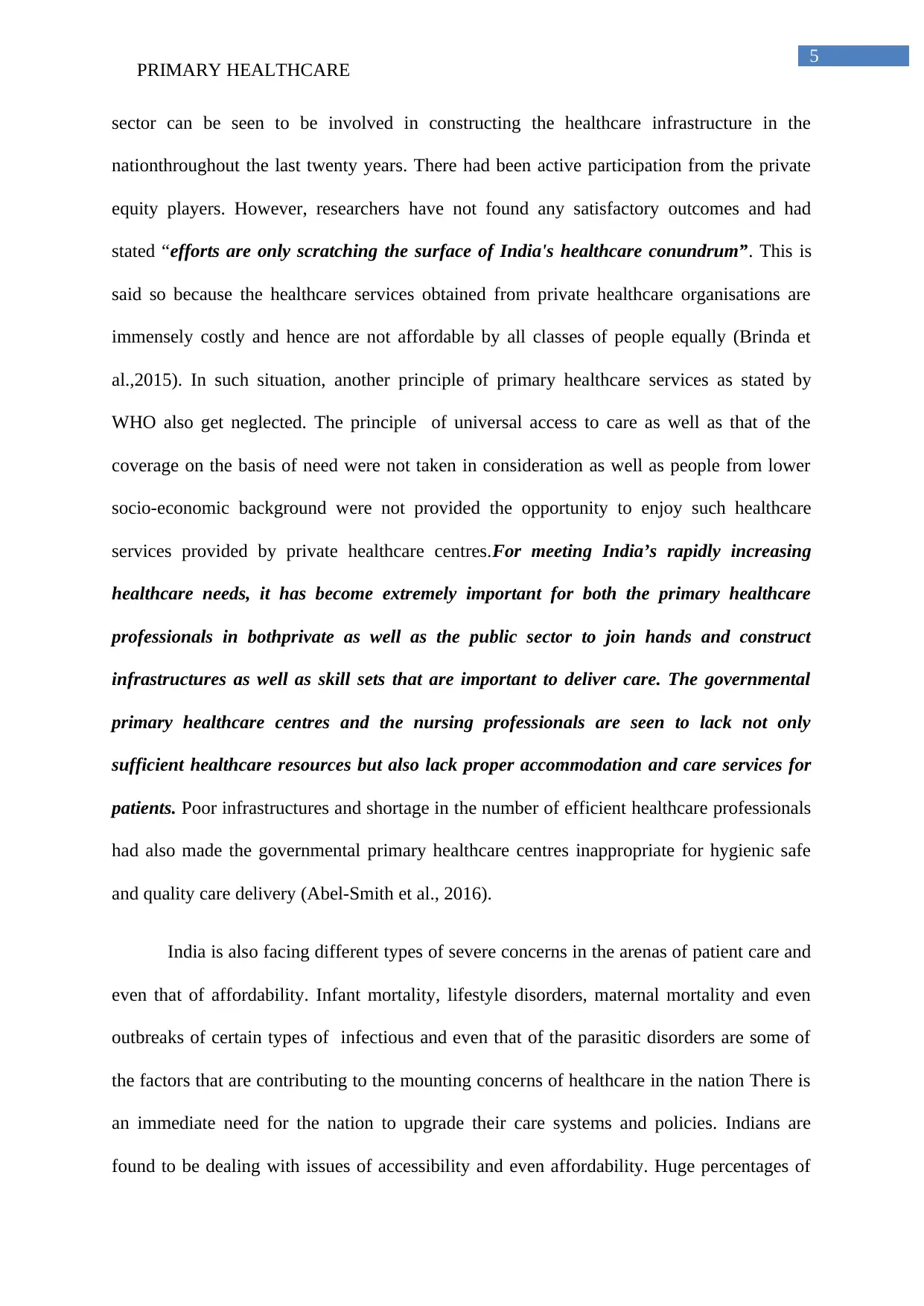
5
PRIMARY HEALTHCARE
sector can be seen to be involved in constructing the healthcare infrastructure in the
nationthroughout the last twenty years. There had been active participation from the private
equity players. However, researchers have not found any satisfactory outcomes and had
stated “efforts are only scratching the surface of India's healthcare conundrum”. This is
said so because the healthcare services obtained from private healthcare organisations are
immensely costly and hence are not affordable by all classes of people equally (Brinda et
al.,2015). In such situation, another principle of primary healthcare services as stated by
WHO also get neglected. The principle of universal access to care as well as that of the
coverage on the basis of need were not taken in consideration as well as people from lower
socio-economic background were not provided the opportunity to enjoy such healthcare
services provided by private healthcare centres.For meeting India’s rapidly increasing
healthcare needs, it has become extremely important for both the primary healthcare
professionals in bothprivate as well as the public sector to join hands and construct
infrastructures as well as skill sets that are important to deliver care. The governmental
primary healthcare centres and the nursing professionals are seen to lack not only
sufficient healthcare resources but also lack proper accommodation and care services for
patients. Poor infrastructures and shortage in the number of efficient healthcare professionals
had also made the governmental primary healthcare centres inappropriate for hygienic safe
and quality care delivery (Abel-Smith et al., 2016).
India is also facing different types of severe concerns in the arenas of patient care and
even that of affordability. Infant mortality, lifestyle disorders, maternal mortality and even
outbreaks of certain types of infectious and even that of the parasitic disorders are some of
the factors that are contributing to the mounting concerns of healthcare in the nation There is
an immediate need for the nation to upgrade their care systems and policies. Indians are
found to be dealing with issues of accessibility and even affordability. Huge percentages of
PRIMARY HEALTHCARE
sector can be seen to be involved in constructing the healthcare infrastructure in the
nationthroughout the last twenty years. There had been active participation from the private
equity players. However, researchers have not found any satisfactory outcomes and had
stated “efforts are only scratching the surface of India's healthcare conundrum”. This is
said so because the healthcare services obtained from private healthcare organisations are
immensely costly and hence are not affordable by all classes of people equally (Brinda et
al.,2015). In such situation, another principle of primary healthcare services as stated by
WHO also get neglected. The principle of universal access to care as well as that of the
coverage on the basis of need were not taken in consideration as well as people from lower
socio-economic background were not provided the opportunity to enjoy such healthcare
services provided by private healthcare centres.For meeting India’s rapidly increasing
healthcare needs, it has become extremely important for both the primary healthcare
professionals in bothprivate as well as the public sector to join hands and construct
infrastructures as well as skill sets that are important to deliver care. The governmental
primary healthcare centres and the nursing professionals are seen to lack not only
sufficient healthcare resources but also lack proper accommodation and care services for
patients. Poor infrastructures and shortage in the number of efficient healthcare professionals
had also made the governmental primary healthcare centres inappropriate for hygienic safe
and quality care delivery (Abel-Smith et al., 2016).
India is also facing different types of severe concerns in the arenas of patient care and
even that of affordability. Infant mortality, lifestyle disorders, maternal mortality and even
outbreaks of certain types of infectious and even that of the parasitic disorders are some of
the factors that are contributing to the mounting concerns of healthcare in the nation There is
an immediate need for the nation to upgrade their care systems and policies. Indians are
found to be dealing with issues of accessibility and even affordability. Huge percentages of
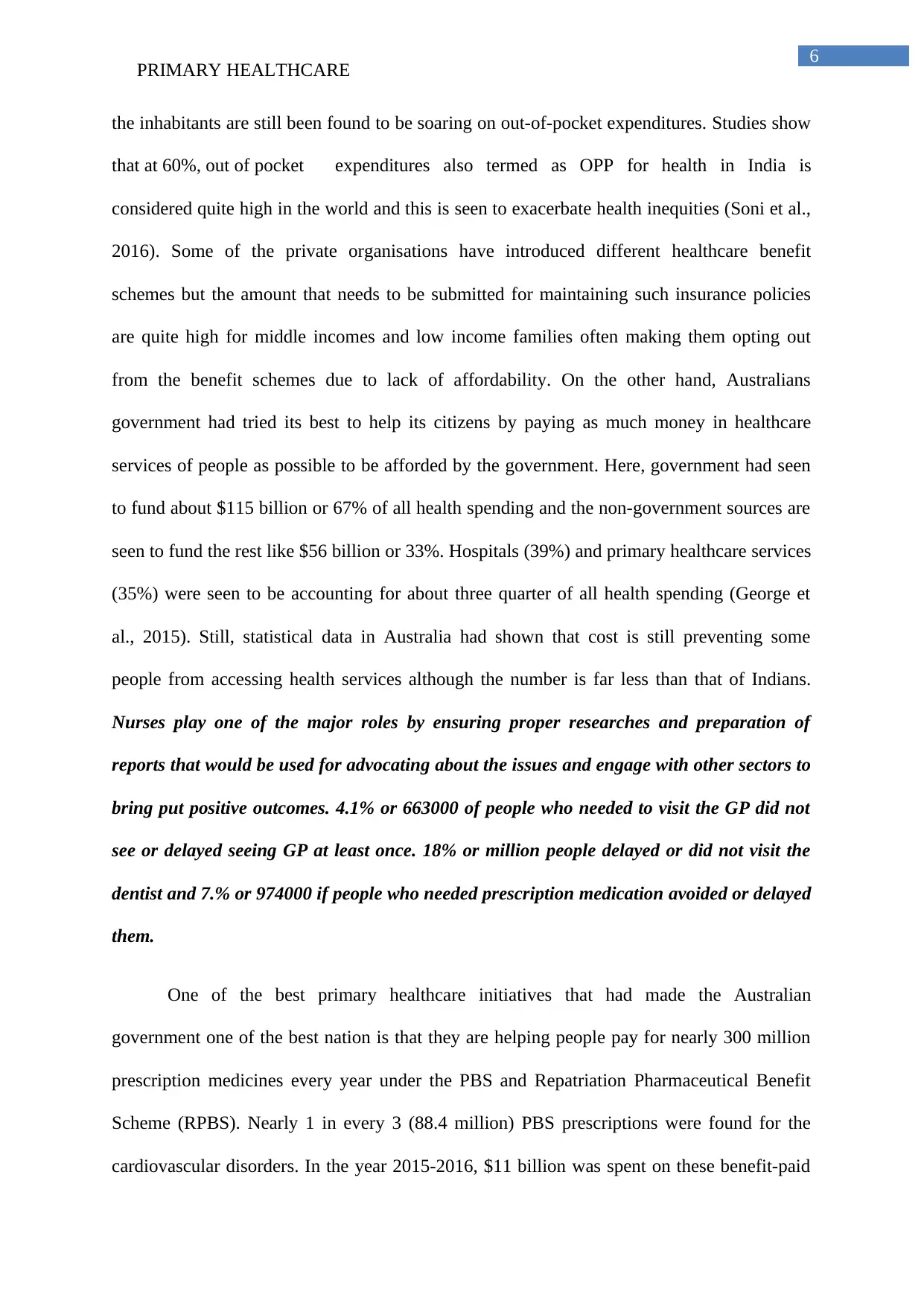
6
PRIMARY HEALTHCARE
the inhabitants are still been found to be soaring on out-of-pocket expenditures. Studies show
that at 60%, out of pocket expenditures also termed as OPP for health in India is
considered quite high in the world and this is seen to exacerbate health inequities (Soni et al.,
2016). Some of the private organisations have introduced different healthcare benefit
schemes but the amount that needs to be submitted for maintaining such insurance policies
are quite high for middle incomes and low income families often making them opting out
from the benefit schemes due to lack of affordability. On the other hand, Australians
government had tried its best to help its citizens by paying as much money in healthcare
services of people as possible to be afforded by the government. Here, government had seen
to fund about $115 billion or 67% of all health spending and the non-government sources are
seen to fund the rest like $56 billion or 33%. Hospitals (39%) and primary healthcare services
(35%) were seen to be accounting for about three quarter of all health spending (George et
al., 2015). Still, statistical data in Australia had shown that cost is still preventing some
people from accessing health services although the number is far less than that of Indians.
Nurses play one of the major roles by ensuring proper researches and preparation of
reports that would be used for advocating about the issues and engage with other sectors to
bring put positive outcomes. 4.1% or 663000 of people who needed to visit the GP did not
see or delayed seeing GP at least once. 18% or million people delayed or did not visit the
dentist and 7.% or 974000 if people who needed prescription medication avoided or delayed
them.
One of the best primary healthcare initiatives that had made the Australian
government one of the best nation is that they are helping people pay for nearly 300 million
prescription medicines every year under the PBS and Repatriation Pharmaceutical Benefit
Scheme (RPBS). Nearly 1 in every 3 (88.4 million) PBS prescriptions were found for the
cardiovascular disorders. In the year 2015-2016, $11 billion was spent on these benefit-paid
PRIMARY HEALTHCARE
the inhabitants are still been found to be soaring on out-of-pocket expenditures. Studies show
that at 60%, out of pocket expenditures also termed as OPP for health in India is
considered quite high in the world and this is seen to exacerbate health inequities (Soni et al.,
2016). Some of the private organisations have introduced different healthcare benefit
schemes but the amount that needs to be submitted for maintaining such insurance policies
are quite high for middle incomes and low income families often making them opting out
from the benefit schemes due to lack of affordability. On the other hand, Australians
government had tried its best to help its citizens by paying as much money in healthcare
services of people as possible to be afforded by the government. Here, government had seen
to fund about $115 billion or 67% of all health spending and the non-government sources are
seen to fund the rest like $56 billion or 33%. Hospitals (39%) and primary healthcare services
(35%) were seen to be accounting for about three quarter of all health spending (George et
al., 2015). Still, statistical data in Australia had shown that cost is still preventing some
people from accessing health services although the number is far less than that of Indians.
Nurses play one of the major roles by ensuring proper researches and preparation of
reports that would be used for advocating about the issues and engage with other sectors to
bring put positive outcomes. 4.1% or 663000 of people who needed to visit the GP did not
see or delayed seeing GP at least once. 18% or million people delayed or did not visit the
dentist and 7.% or 974000 if people who needed prescription medication avoided or delayed
them.
One of the best primary healthcare initiatives that had made the Australian
government one of the best nation is that they are helping people pay for nearly 300 million
prescription medicines every year under the PBS and Repatriation Pharmaceutical Benefit
Scheme (RPBS). Nearly 1 in every 3 (88.4 million) PBS prescriptions were found for the
cardiovascular disorders. In the year 2015-2016, $11 billion was spent on these benefit-paid
Paraphrase This Document
Need a fresh take? Get an instant paraphrase of this document with our AI Paraphraser
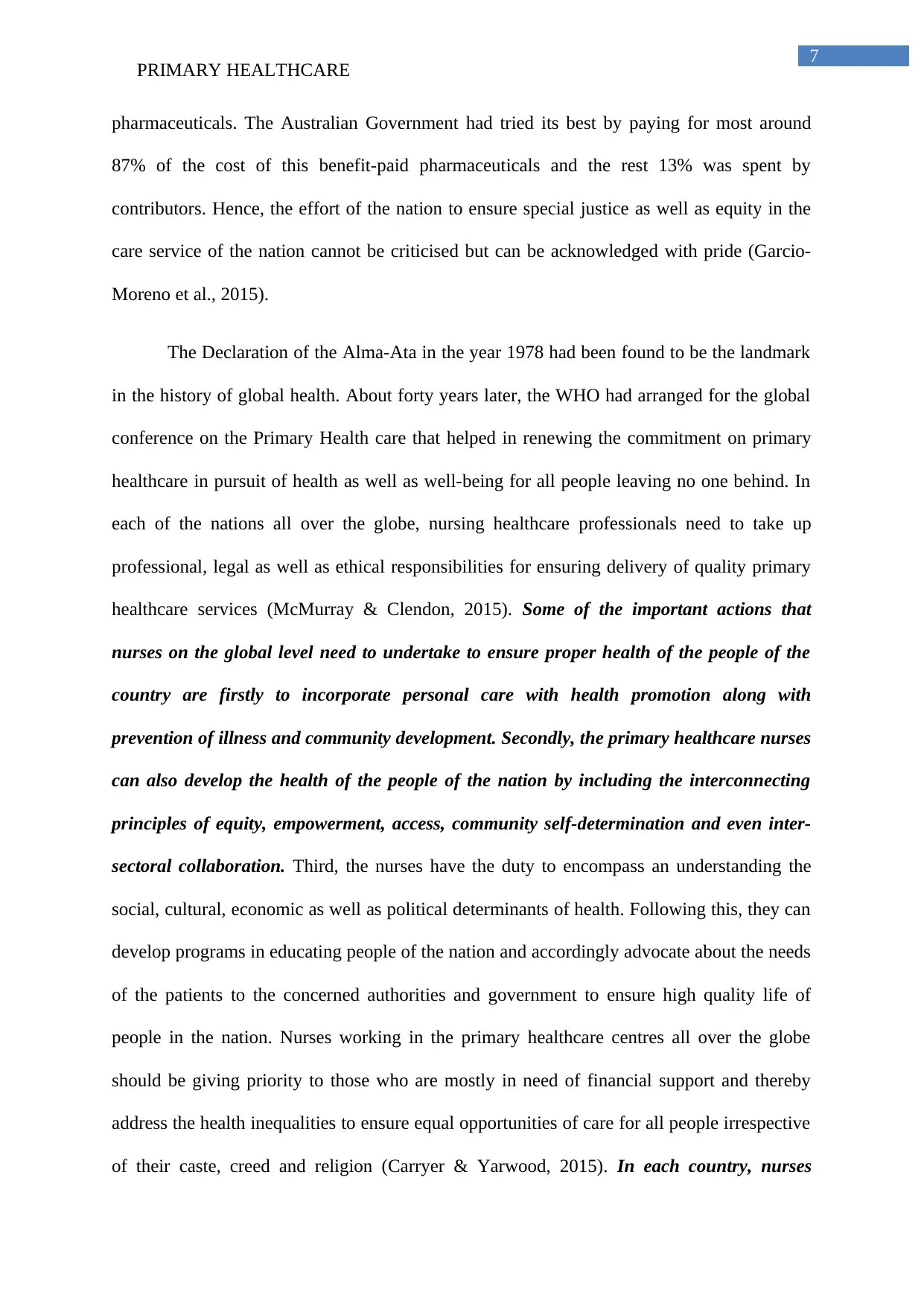
7
PRIMARY HEALTHCARE
pharmaceuticals. The Australian Government had tried its best by paying for most around
87% of the cost of this benefit-paid pharmaceuticals and the rest 13% was spent by
contributors. Hence, the effort of the nation to ensure special justice as well as equity in the
care service of the nation cannot be criticised but can be acknowledged with pride (Garcio-
Moreno et al., 2015).
The Declaration of the Alma-Ata in the year 1978 had been found to be the landmark
in the history of global health. About forty years later, the WHO had arranged for the global
conference on the Primary Health care that helped in renewing the commitment on primary
healthcare in pursuit of health as well as well-being for all people leaving no one behind. In
each of the nations all over the globe, nursing healthcare professionals need to take up
professional, legal as well as ethical responsibilities for ensuring delivery of quality primary
healthcare services (McMurray & Clendon, 2015). Some of the important actions that
nurses on the global level need to undertake to ensure proper health of the people of the
country are firstly to incorporate personal care with health promotion along with
prevention of illness and community development. Secondly, the primary healthcare nurses
can also develop the health of the people of the nation by including the interconnecting
principles of equity, empowerment, access, community self-determination and even inter-
sectoral collaboration. Third, the nurses have the duty to encompass an understanding the
social, cultural, economic as well as political determinants of health. Following this, they can
develop programs in educating people of the nation and accordingly advocate about the needs
of the patients to the concerned authorities and government to ensure high quality life of
people in the nation. Nurses working in the primary healthcare centres all over the globe
should be giving priority to those who are mostly in need of financial support and thereby
address the health inequalities to ensure equal opportunities of care for all people irrespective
of their caste, creed and religion (Carryer & Yarwood, 2015). In each country, nurses
PRIMARY HEALTHCARE
pharmaceuticals. The Australian Government had tried its best by paying for most around
87% of the cost of this benefit-paid pharmaceuticals and the rest 13% was spent by
contributors. Hence, the effort of the nation to ensure special justice as well as equity in the
care service of the nation cannot be criticised but can be acknowledged with pride (Garcio-
Moreno et al., 2015).
The Declaration of the Alma-Ata in the year 1978 had been found to be the landmark
in the history of global health. About forty years later, the WHO had arranged for the global
conference on the Primary Health care that helped in renewing the commitment on primary
healthcare in pursuit of health as well as well-being for all people leaving no one behind. In
each of the nations all over the globe, nursing healthcare professionals need to take up
professional, legal as well as ethical responsibilities for ensuring delivery of quality primary
healthcare services (McMurray & Clendon, 2015). Some of the important actions that
nurses on the global level need to undertake to ensure proper health of the people of the
country are firstly to incorporate personal care with health promotion along with
prevention of illness and community development. Secondly, the primary healthcare nurses
can also develop the health of the people of the nation by including the interconnecting
principles of equity, empowerment, access, community self-determination and even inter-
sectoral collaboration. Third, the nurses have the duty to encompass an understanding the
social, cultural, economic as well as political determinants of health. Following this, they can
develop programs in educating people of the nation and accordingly advocate about the needs
of the patients to the concerned authorities and government to ensure high quality life of
people in the nation. Nurses working in the primary healthcare centres all over the globe
should be giving priority to those who are mostly in need of financial support and thereby
address the health inequalities to ensure equal opportunities of care for all people irrespective
of their caste, creed and religion (Carryer & Yarwood, 2015). In each country, nurses
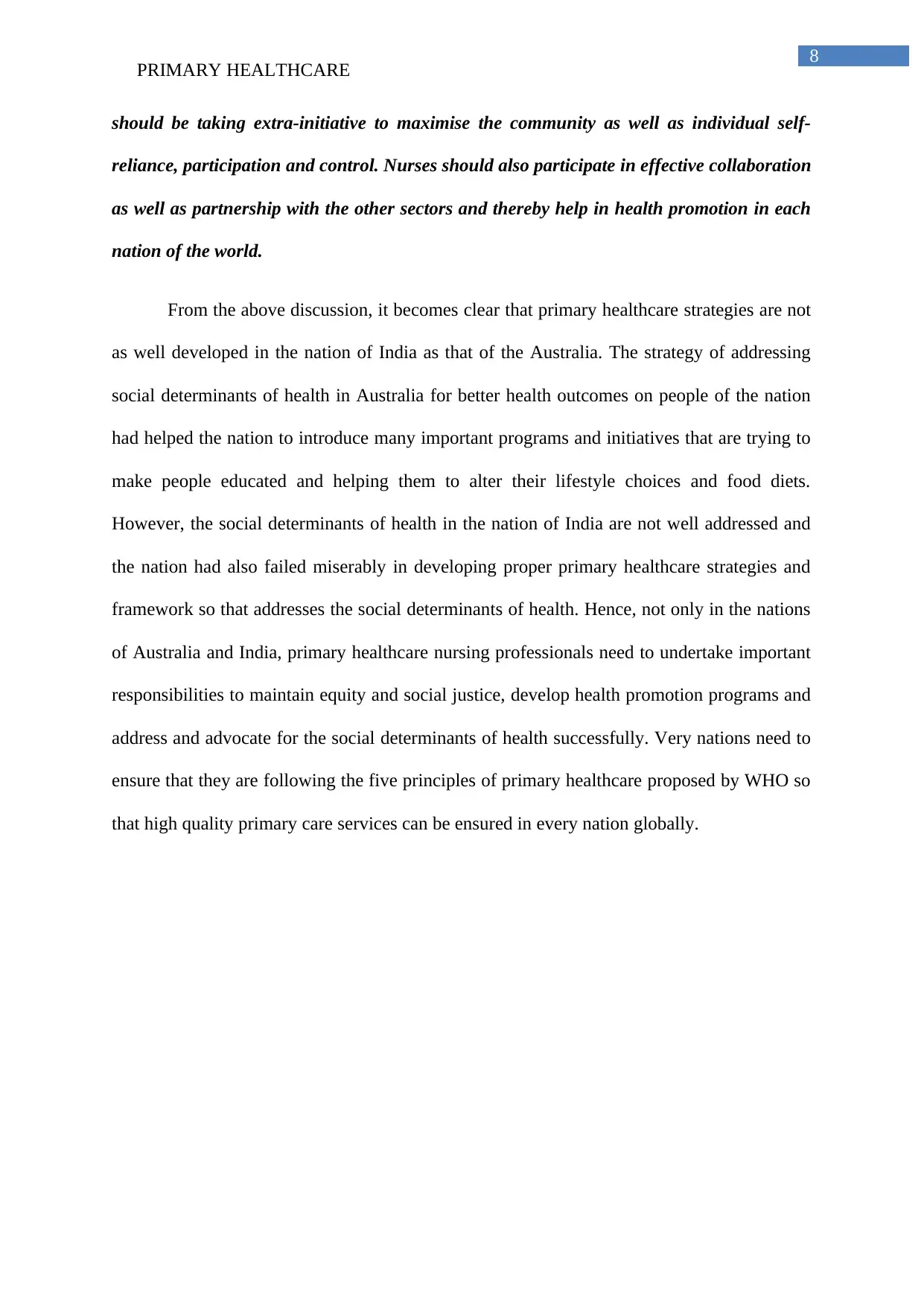
8
PRIMARY HEALTHCARE
should be taking extra-initiative to maximise the community as well as individual self-
reliance, participation and control. Nurses should also participate in effective collaboration
as well as partnership with the other sectors and thereby help in health promotion in each
nation of the world.
From the above discussion, it becomes clear that primary healthcare strategies are not
as well developed in the nation of India as that of the Australia. The strategy of addressing
social determinants of health in Australia for better health outcomes on people of the nation
had helped the nation to introduce many important programs and initiatives that are trying to
make people educated and helping them to alter their lifestyle choices and food diets.
However, the social determinants of health in the nation of India are not well addressed and
the nation had also failed miserably in developing proper primary healthcare strategies and
framework so that addresses the social determinants of health. Hence, not only in the nations
of Australia and India, primary healthcare nursing professionals need to undertake important
responsibilities to maintain equity and social justice, develop health promotion programs and
address and advocate for the social determinants of health successfully. Very nations need to
ensure that they are following the five principles of primary healthcare proposed by WHO so
that high quality primary care services can be ensured in every nation globally.
PRIMARY HEALTHCARE
should be taking extra-initiative to maximise the community as well as individual self-
reliance, participation and control. Nurses should also participate in effective collaboration
as well as partnership with the other sectors and thereby help in health promotion in each
nation of the world.
From the above discussion, it becomes clear that primary healthcare strategies are not
as well developed in the nation of India as that of the Australia. The strategy of addressing
social determinants of health in Australia for better health outcomes on people of the nation
had helped the nation to introduce many important programs and initiatives that are trying to
make people educated and helping them to alter their lifestyle choices and food diets.
However, the social determinants of health in the nation of India are not well addressed and
the nation had also failed miserably in developing proper primary healthcare strategies and
framework so that addresses the social determinants of health. Hence, not only in the nations
of Australia and India, primary healthcare nursing professionals need to undertake important
responsibilities to maintain equity and social justice, develop health promotion programs and
address and advocate for the social determinants of health successfully. Very nations need to
ensure that they are following the five principles of primary healthcare proposed by WHO so
that high quality primary care services can be ensured in every nation globally.

9
PRIMARY HEALTHCARE
References:
Abel-Smith, B. (2016). An introduction to health: policy, planning and financing. Routledge.
https://www.taylorfrancis.com/books/9781317891833
Agarwal, R., Jain, P., Ghosh, M. S., & Parihar, K. S. (2017). Importance of Primary Health
Care in the Society. International Journal of Health Sciences (IJHS), 1(1), 6-11.
https://doi.org/10.21744/ijhs.v1i1.17
Australian Government, D. (2013). NATIONAL PRIMARY HEALTH CARE STRATEGIC
FRAMEWORK. Retrieved from
http://www.health.gov.au/internet/main/publishing.nsf/Content/6084A04118674329C
A257BF0001A349E/$File/NPHCframe.pdf.
Baum, F., Freeman, T., Sanders, D., Labonté, R., Lawless, A., & Javanparast, S. (2016).
Comprehensive primary health care under neo-liberalism in Australia. Social Science
& Medicine, 168, 43-52. https://doi.org/10.1016/j.socscimed.2016.09.005
Brinda, E. M., Kowal, P., Attermann, J., & Enemark, U. (2015). Health service use, out-of-
pocket payments and catastrophic health expenditure among older people in India:
The WHO Study on global AGEing and adult health (SAGE). J Epidemiol
Community Health, 69(5), 489-494. https://jech.bmj.com/content/69/5/489.short
Carryer, J., & Yarwood, J. (2015). The nurse practitioner role: Solution or servant in
improving primary health care service delivery. Collegian, 22(2), 169-174.
https://doi.org/10.1016/j.colegn.2015.02.004
Freeman, T., Baum, F., Lawless, A., Javanparast, S., Jolley, G., Labonté, R., ... & Sanders, D.
(2016). Revisiting the ability of Australian primary healthcare services to respond to
PRIMARY HEALTHCARE
References:
Abel-Smith, B. (2016). An introduction to health: policy, planning and financing. Routledge.
https://www.taylorfrancis.com/books/9781317891833
Agarwal, R., Jain, P., Ghosh, M. S., & Parihar, K. S. (2017). Importance of Primary Health
Care in the Society. International Journal of Health Sciences (IJHS), 1(1), 6-11.
https://doi.org/10.21744/ijhs.v1i1.17
Australian Government, D. (2013). NATIONAL PRIMARY HEALTH CARE STRATEGIC
FRAMEWORK. Retrieved from
http://www.health.gov.au/internet/main/publishing.nsf/Content/6084A04118674329C
A257BF0001A349E/$File/NPHCframe.pdf.
Baum, F., Freeman, T., Sanders, D., Labonté, R., Lawless, A., & Javanparast, S. (2016).
Comprehensive primary health care under neo-liberalism in Australia. Social Science
& Medicine, 168, 43-52. https://doi.org/10.1016/j.socscimed.2016.09.005
Brinda, E. M., Kowal, P., Attermann, J., & Enemark, U. (2015). Health service use, out-of-
pocket payments and catastrophic health expenditure among older people in India:
The WHO Study on global AGEing and adult health (SAGE). J Epidemiol
Community Health, 69(5), 489-494. https://jech.bmj.com/content/69/5/489.short
Carryer, J., & Yarwood, J. (2015). The nurse practitioner role: Solution or servant in
improving primary health care service delivery. Collegian, 22(2), 169-174.
https://doi.org/10.1016/j.colegn.2015.02.004
Freeman, T., Baum, F., Lawless, A., Javanparast, S., Jolley, G., Labonté, R., ... & Sanders, D.
(2016). Revisiting the ability of Australian primary healthcare services to respond to
Secure Best Marks with AI Grader
Need help grading? Try our AI Grader for instant feedback on your assignments.
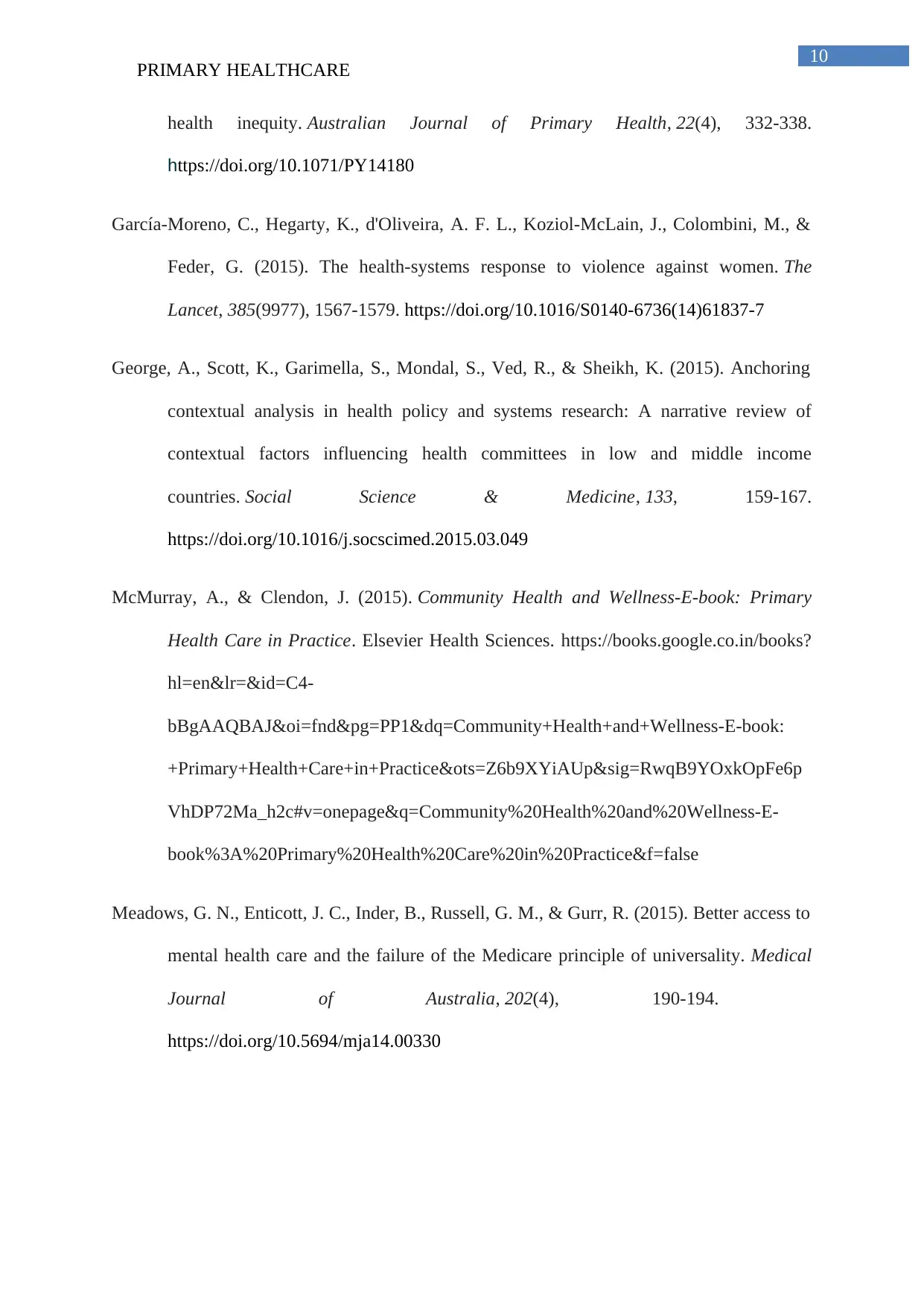
10
PRIMARY HEALTHCARE
health inequity. Australian Journal of Primary Health, 22(4), 332-338.
https://doi.org/10.1071/PY14180
García-Moreno, C., Hegarty, K., d'Oliveira, A. F. L., Koziol-McLain, J., Colombini, M., &
Feder, G. (2015). The health-systems response to violence against women. The
Lancet, 385(9977), 1567-1579. https://doi.org/10.1016/S0140-6736(14)61837-7
George, A., Scott, K., Garimella, S., Mondal, S., Ved, R., & Sheikh, K. (2015). Anchoring
contextual analysis in health policy and systems research: A narrative review of
contextual factors influencing health committees in low and middle income
countries. Social Science & Medicine, 133, 159-167.
https://doi.org/10.1016/j.socscimed.2015.03.049
McMurray, A., & Clendon, J. (2015). Community Health and Wellness-E-book: Primary
Health Care in Practice. Elsevier Health Sciences. https://books.google.co.in/books?
hl=en&lr=&id=C4-
bBgAAQBAJ&oi=fnd&pg=PP1&dq=Community+Health+and+Wellness-E-book:
+Primary+Health+Care+in+Practice&ots=Z6b9XYiAUp&sig=RwqB9YOxkOpFe6p
VhDP72Ma_h2c#v=onepage&q=Community%20Health%20and%20Wellness-E-
book%3A%20Primary%20Health%20Care%20in%20Practice&f=false
Meadows, G. N., Enticott, J. C., Inder, B., Russell, G. M., & Gurr, R. (2015). Better access to
mental health care and the failure of the Medicare principle of universality. Medical
Journal of Australia, 202(4), 190-194.
https://doi.org/10.5694/mja14.00330
PRIMARY HEALTHCARE
health inequity. Australian Journal of Primary Health, 22(4), 332-338.
https://doi.org/10.1071/PY14180
García-Moreno, C., Hegarty, K., d'Oliveira, A. F. L., Koziol-McLain, J., Colombini, M., &
Feder, G. (2015). The health-systems response to violence against women. The
Lancet, 385(9977), 1567-1579. https://doi.org/10.1016/S0140-6736(14)61837-7
George, A., Scott, K., Garimella, S., Mondal, S., Ved, R., & Sheikh, K. (2015). Anchoring
contextual analysis in health policy and systems research: A narrative review of
contextual factors influencing health committees in low and middle income
countries. Social Science & Medicine, 133, 159-167.
https://doi.org/10.1016/j.socscimed.2015.03.049
McMurray, A., & Clendon, J. (2015). Community Health and Wellness-E-book: Primary
Health Care in Practice. Elsevier Health Sciences. https://books.google.co.in/books?
hl=en&lr=&id=C4-
bBgAAQBAJ&oi=fnd&pg=PP1&dq=Community+Health+and+Wellness-E-book:
+Primary+Health+Care+in+Practice&ots=Z6b9XYiAUp&sig=RwqB9YOxkOpFe6p
VhDP72Ma_h2c#v=onepage&q=Community%20Health%20and%20Wellness-E-
book%3A%20Primary%20Health%20Care%20in%20Practice&f=false
Meadows, G. N., Enticott, J. C., Inder, B., Russell, G. M., & Gurr, R. (2015). Better access to
mental health care and the failure of the Medicare principle of universality. Medical
Journal of Australia, 202(4), 190-194.
https://doi.org/10.5694/mja14.00330
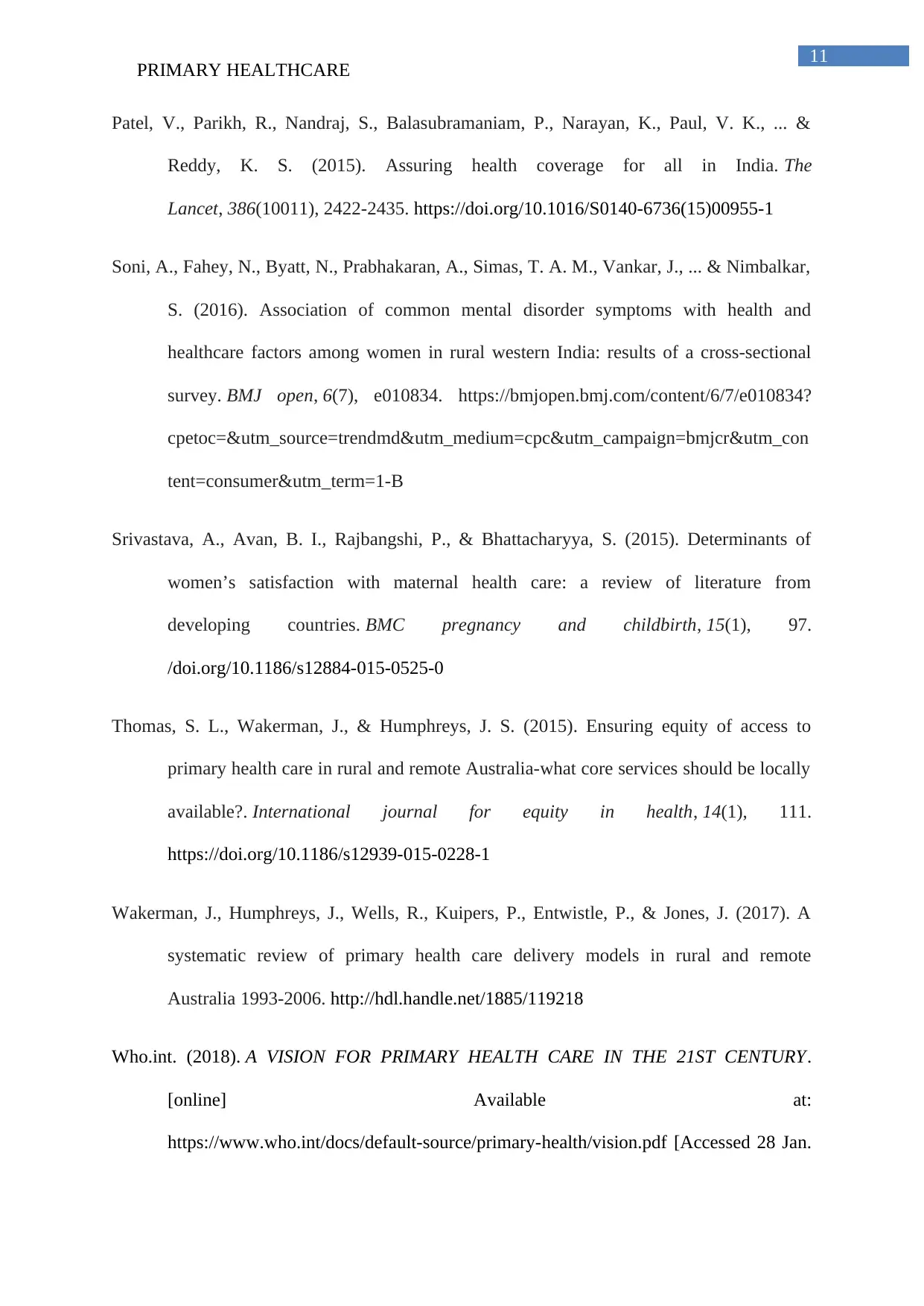
11
PRIMARY HEALTHCARE
Patel, V., Parikh, R., Nandraj, S., Balasubramaniam, P., Narayan, K., Paul, V. K., ... &
Reddy, K. S. (2015). Assuring health coverage for all in India. The
Lancet, 386(10011), 2422-2435. https://doi.org/10.1016/S0140-6736(15)00955-1
Soni, A., Fahey, N., Byatt, N., Prabhakaran, A., Simas, T. A. M., Vankar, J., ... & Nimbalkar,
S. (2016). Association of common mental disorder symptoms with health and
healthcare factors among women in rural western India: results of a cross-sectional
survey. BMJ open, 6(7), e010834. https://bmjopen.bmj.com/content/6/7/e010834?
cpetoc=&utm_source=trendmd&utm_medium=cpc&utm_campaign=bmjcr&utm_con
tent=consumer&utm_term=1-B
Srivastava, A., Avan, B. I., Rajbangshi, P., & Bhattacharyya, S. (2015). Determinants of
women’s satisfaction with maternal health care: a review of literature from
developing countries. BMC pregnancy and childbirth, 15(1), 97.
/doi.org/10.1186/s12884-015-0525-0
Thomas, S. L., Wakerman, J., & Humphreys, J. S. (2015). Ensuring equity of access to
primary health care in rural and remote Australia-what core services should be locally
available?. International journal for equity in health, 14(1), 111.
https://doi.org/10.1186/s12939-015-0228-1
Wakerman, J., Humphreys, J., Wells, R., Kuipers, P., Entwistle, P., & Jones, J. (2017). A
systematic review of primary health care delivery models in rural and remote
Australia 1993-2006. http://hdl.handle.net/1885/119218
Who.int. (2018). A VISION FOR PRIMARY HEALTH CARE IN THE 21ST CENTURY.
[online] Available at:
https://www.who.int/docs/default-source/primary-health/vision.pdf [Accessed 28 Jan.
PRIMARY HEALTHCARE
Patel, V., Parikh, R., Nandraj, S., Balasubramaniam, P., Narayan, K., Paul, V. K., ... &
Reddy, K. S. (2015). Assuring health coverage for all in India. The
Lancet, 386(10011), 2422-2435. https://doi.org/10.1016/S0140-6736(15)00955-1
Soni, A., Fahey, N., Byatt, N., Prabhakaran, A., Simas, T. A. M., Vankar, J., ... & Nimbalkar,
S. (2016). Association of common mental disorder symptoms with health and
healthcare factors among women in rural western India: results of a cross-sectional
survey. BMJ open, 6(7), e010834. https://bmjopen.bmj.com/content/6/7/e010834?
cpetoc=&utm_source=trendmd&utm_medium=cpc&utm_campaign=bmjcr&utm_con
tent=consumer&utm_term=1-B
Srivastava, A., Avan, B. I., Rajbangshi, P., & Bhattacharyya, S. (2015). Determinants of
women’s satisfaction with maternal health care: a review of literature from
developing countries. BMC pregnancy and childbirth, 15(1), 97.
/doi.org/10.1186/s12884-015-0525-0
Thomas, S. L., Wakerman, J., & Humphreys, J. S. (2015). Ensuring equity of access to
primary health care in rural and remote Australia-what core services should be locally
available?. International journal for equity in health, 14(1), 111.
https://doi.org/10.1186/s12939-015-0228-1
Wakerman, J., Humphreys, J., Wells, R., Kuipers, P., Entwistle, P., & Jones, J. (2017). A
systematic review of primary health care delivery models in rural and remote
Australia 1993-2006. http://hdl.handle.net/1885/119218
Who.int. (2018). A VISION FOR PRIMARY HEALTH CARE IN THE 21ST CENTURY.
[online] Available at:
https://www.who.int/docs/default-source/primary-health/vision.pdf [Accessed 28 Jan.
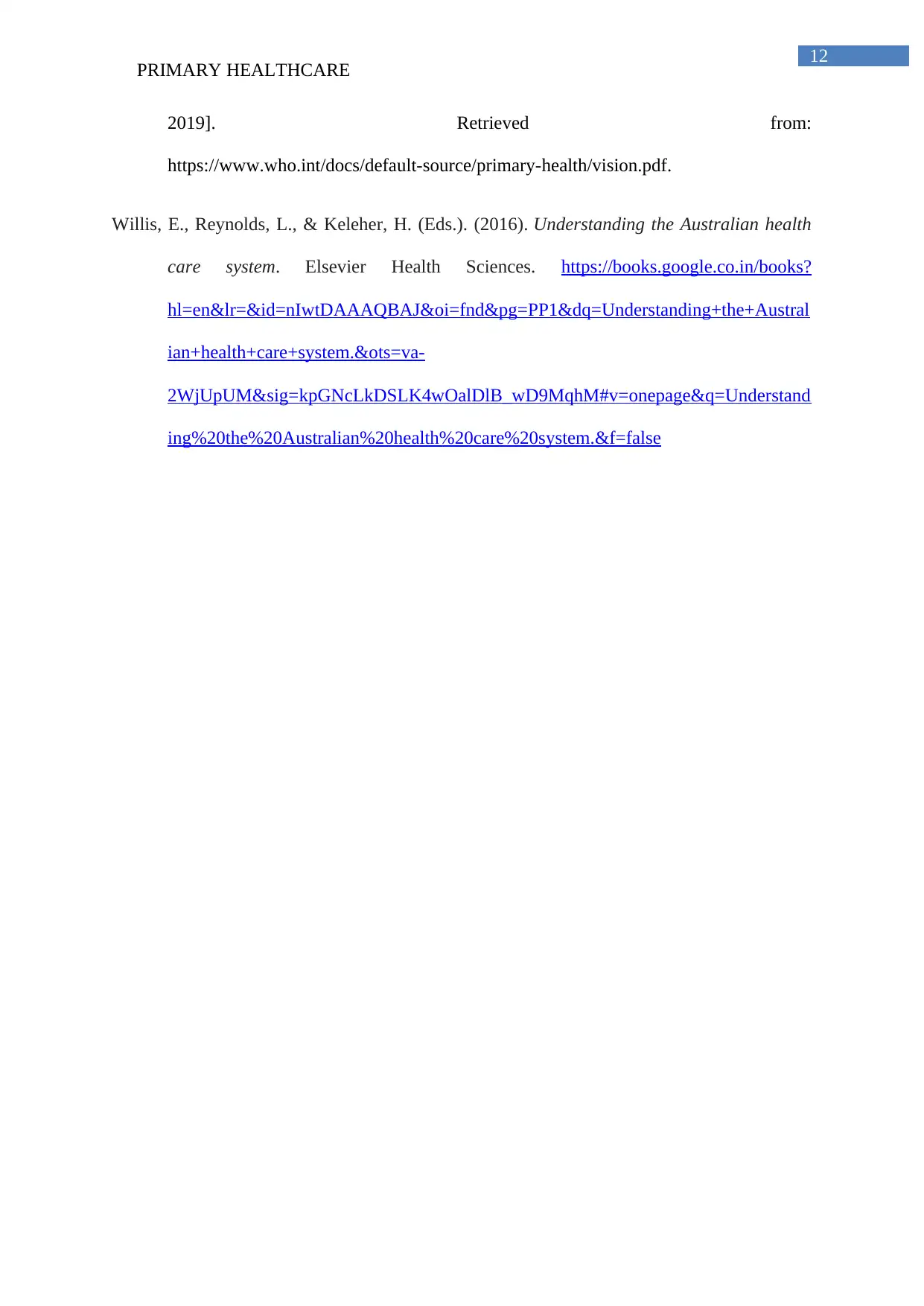
12
PRIMARY HEALTHCARE
2019]. Retrieved from:
https://www.who.int/docs/default-source/primary-health/vision.pdf.
Willis, E., Reynolds, L., & Keleher, H. (Eds.). (2016). Understanding the Australian health
care system. Elsevier Health Sciences. https://books.google.co.in/books?
hl=en&lr=&id=nIwtDAAAQBAJ&oi=fnd&pg=PP1&dq=Understanding+the+Austral
ian+health+care+system.&ots=va-
2WjUpUM&sig=kpGNcLkDSLK4wOalDlB_wD9MqhM#v=onepage&q=Understand
ing%20the%20Australian%20health%20care%20system.&f=false
PRIMARY HEALTHCARE
2019]. Retrieved from:
https://www.who.int/docs/default-source/primary-health/vision.pdf.
Willis, E., Reynolds, L., & Keleher, H. (Eds.). (2016). Understanding the Australian health
care system. Elsevier Health Sciences. https://books.google.co.in/books?
hl=en&lr=&id=nIwtDAAAQBAJ&oi=fnd&pg=PP1&dq=Understanding+the+Austral
ian+health+care+system.&ots=va-
2WjUpUM&sig=kpGNcLkDSLK4wOalDlB_wD9MqhM#v=onepage&q=Understand
ing%20the%20Australian%20health%20care%20system.&f=false
1 out of 13
Related Documents
Your All-in-One AI-Powered Toolkit for Academic Success.
+13062052269
info@desklib.com
Available 24*7 on WhatsApp / Email
![[object Object]](/_next/static/media/star-bottom.7253800d.svg)
Unlock your academic potential
© 2024 | Zucol Services PVT LTD | All rights reserved.





